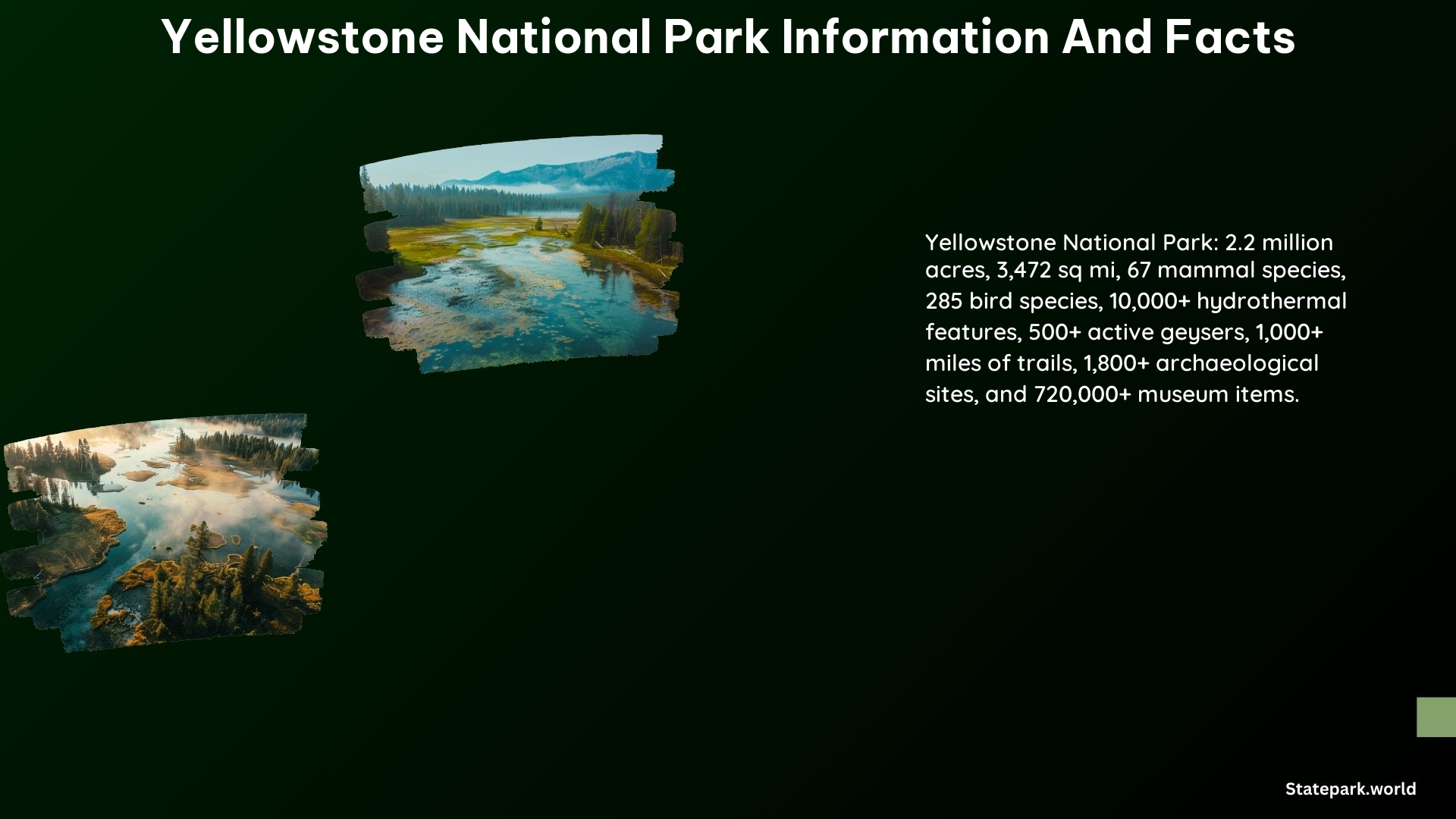Yellowstone National Park is a vast and diverse natural wonder located primarily in northwestern Wyoming, with smaller portions in southern Montana and eastern Idaho. This blog post will provide detailed information and fascinating facts about Yellowstone National Park, catering to the interests of national park touring enthusiasts.
Size and Location of Yellowstone National Park
Yellowstone National Park is the largest national park in the United States, covering an area of 3,472 square miles (8,992 square kilometers). To put this into perspective, the park is larger than the combined areas of Rhode Island and Delaware. The park’s shape is a squarelike rectangle with an irregular eastern side, measuring 63 miles (101 kilometers) from north to south and 54 miles (87 kilometers) from east to west at its widest point.
Yellowstone National Park is primarily located in the northwestern corner of Wyoming, with smaller portions extending into southern Montana and eastern Idaho. The park’s diverse landscape spans across three states, offering visitors a unique and expansive natural experience.
Unique Geological Features of Yellowstone National Park

Yellowstone National Park is renowned for its remarkable geological features, which are the result of its active volcanic history. The park sits atop an active supervolcano, with a hotspot beneath the surface that has caused massive eruptions in the past. This volcanic activity has given rise to a variety of fascinating geological formations and hydrothermal features.
Caldera
One of the most notable geological features of Yellowstone is its massive caldera, which measures 45 by 30 miles (72 by 48 kilometers). This caldera is the result of a series of large volcanic eruptions that occurred over the past 2.1 million years, making it one of the world’s largest calderas.
Hydrothermal Features
Yellowstone is home to over 10,000 hydrothermal features, including geysers, hot springs, mud pots, and fumaroles. The park boasts more than 500 active geysers, which is more than half of all active geysers worldwide. These geothermal wonders are a result of the park’s volcanic activity and the interaction between the Earth’s crust and the underlying magma.
Earthquakes
Yellowstone National Park experiences a high level of seismic activity, with 1,000 to 3,000 earthquakes occurring annually. This seismic activity is closely linked to the park’s volcanic history and the ongoing geologic processes that shape the landscape.
Wildlife and Vegetation of Yellowstone National Park
Yellowstone National Park is home to a diverse array of wildlife and vegetation, reflecting the park’s varied ecosystems and habitats.
Mammals
The park is home to 67 species of mammals, including seven native ungulates (hoofed animals) and two bear species: the grizzly bear and the black bear.
Birds
Yellowstone is a haven for birdwatchers, with 285 species of birds, including 150 nesting species.
Fish
The park’s waterways are home to 16 species of fish, including five non-native species.
Vegetation
Yellowstone’s vegetation is equally diverse, with nine conifer species, over 1,000 native flowering species, and 225 invasive plant species.
Cultural Resources and Facilities in Yellowstone National Park
Yellowstone National Park is not only a natural wonder but also a place rich in cultural history and resources.
Native American Tribes
The park is associated with 26 Native American tribes, each with their own unique cultural traditions and connections to the land.
Archaeological Sites
Yellowstone National Park boasts over 1,800 known archaeological sites, providing insights into the park’s long history of human habitation.
Historic Buildings
The park is home to over 900 historic buildings, including 30 historic vehicles and millions of archived documents, offering visitors a glimpse into the park’s past.
Visitor Centers and Campgrounds
Yellowstone National Park offers a range of visitor facilities, including 11 visitor centers, museums, and contact stations, as well as 7 NPS-operated campgrounds and 5 concession-operated campgrounds.
Visitation and Budget of Yellowstone National Park
Yellowstone National Park is a popular destination, attracting millions of visitors each year. In 2022, the park recorded 3.3 million visits, down 32% from the record year of 2021. The park’s total budget for Fiscal Year 2022 was $132.2 million, with $94.5 million coming from federal funding and $28.7 million from other sources.
Other Notable Facts about Yellowstone National Park
- Yellowstone was established as the world’s first national park on March 1, 1872.
- The park has been designated a UNESCO biosphere reserve in 1976 and a World Heritage site in 1978, recognizing its global significance.
Yellowstone National Park is a truly remarkable and unique natural wonder, offering visitors a chance to explore its vast landscapes, diverse wildlife, and fascinating geological features. Whether you’re a seasoned national park enthusiast or a first-time visitor, Yellowstone is sure to leave a lasting impression.
References:
1. https://www.britannica.com/place/Yellowstone-National-Park
2. https://www.yellowstone.org/10-yellowstone-facts/
3. https://www.yellowstone.org/experience/visitor-information/yellowstone-national-park-facts/
4. https://www.nps.gov/yell/planyourvisit/parkfacts.htm
5. https://www.nps.gov/yell/index.htm
